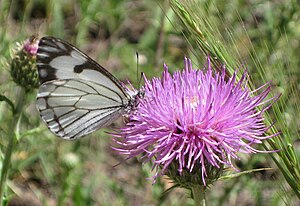Neophasia menapia
| Neophasia menapia | ||||||||||||
|---|---|---|---|---|---|---|---|---|---|---|---|---|

Neophasia menapia |
||||||||||||
| Systematics | ||||||||||||
|
||||||||||||
| Scientific name | ||||||||||||
| Neophasia menapia | ||||||||||||
| ( C. Felder & R. Felder , 1859) |
Neophasia menapia is a butterfly ( butterfly ) from the family of Whites (Pieridae).
features
butterfly
The wingspan of the moth is 45 to 58 millimeters. They have a white basic wing color. On the upper side of the forewings , a narrow black band runs from the wing root, along the anterior margin and ends in the discoidal spot . With this characteristic, the species is unmistakable. A wide, dark band in the submarginal region does not reach the inner margin and has some light shadows near the apex . On the upper and lower sides of the white, unmarked hind wings, the veins clearly stand out in black color.
Egg, caterpillar, pupa
The blue-green eggs have approximately the shape of a double cone rounded at the ends with a small whitish crown on the top. They are provided with transverse ribs on the entire surface and are placed in a row between three and 22 pieces on the needle of a food plant.
Adult caterpillars are green in color, sometimes shimmering slightly purple and are provided with white longitudinal lines. At the end there are two short tails.
The males' dump pupa is yellow-green, while that of the females is dark brown and has yellow-white lines.
distribution and habitat
The range of Polygonia faunus extends from British Columbia south through the western and some middle states of the USA to California . The type settled preferably with pines ( Pinus (English:) Pine ) lined forests, which is why they in English usage as Pine White is called.
Way of life
The species forms one generation per year. The main flight time is from July to September. The moths like to suckle on flowers to ingest food. Young caterpillars live gregariously, older ones individually. Spun nests are not created. They feed on the needles of a large number of different pine trees (Pinaceae), especially the yellow pine ( Pinus ponderosa ). Other food crops include the following conifers: West American hemlock ( Tsuga heterophylla ), balsam fir ( Abies balsamea ), coastal fir ( Abies grandis ) or Sitka spruce ( Picea sitchensis ). As a forest pest , they are extremely rare. The species overwinters as an egg.
Subspecies
In addition to the nominate form Neophasia menapia menapia , the following subspecies are distinguished:
- Neophasia menapia magnamesapia
- Neophasia menapia melanica
- Neophasia menapia tau
- Neophasia menapia tehachapina
swell
Individual evidence
- ^ Butterflies and Moth of North America http://www.butterfliesandmoths.org/species/Neophasia-menapia
- ↑ a b c d e James A. Scott: The Butterflies of North America: A Natural History and Field Guide. Stanford, California: Stanford University Press, 1986, ISBN 0-8047-2013-4 , pp. 225/226
- ↑ Distribution http://www.nic.funet.fi/pub/sci/bio/life/insecta/lepidoptera/ditrysia/papilionoidea/pieridae/pierinae/neophasia/index.html
- ^ Encyclopedia of Life http://eol.org/pages/180210/overview
literature
- James A. Scott: The Butterflies of North America , Stanford University Press, Stanford CA., 1992, ISBN 0-8047-2013-4 , pp. 225/226
Web links
- Carolina Nature - Butterflies of Canada
- butterfly.ucdavis.edu - Art Shapiro's Butterfly Site